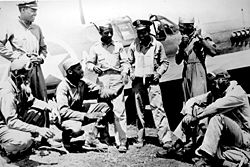| Line 1: | Line 1: | ||
| − | '''[[ | + | '''[[John Parker]]''' <br> |
| − | [[Image: | + | [[Image:Tuskegee_airmen_%28archive_photo%29.jpg|John Parker|250px]]<br>''Compared to any white child born in 1919, John Parker was poor, pure and simple. But compared to other African-American families of the time, Parker was indeed fortunate. |
| − | '' | + | ''His father had a steady manufacturing job in Kansas City, Kan., and his mother got part time work teaching music lessons, with no institution willing to hire on a “Negro” to a full-time job in the schools. Because of his mother, John grew up learning music at her knee, and quickly proved adept at the saxophone. He scraped together enough collecting scrap metal to purchase his own instrument, a beloved silver plated C.G. Conn tenor sax. From the day he bought it, it was never far from his side. When the depression hit, his father lost his manufacturing job, and the 10-year-old John kept the family afloat by playing on the street corners after school. He was skilled enough, he landed weekend gigs playing in local Kansas City venues and fell in love the burgeoning and popular jazz arising in the city. |
| + | |||
| + | ''Parker's 1934 C.G. Conn brand 'New Wonder' Series II silver-plated tenor saxophone, which he calls simply "Lady." (Source: Tom Oates, 2011) | ||
| + | |||
| + | ''These gigs meant that in addition to his family surviving, John could tuck a little away for college. In 1939, he attended Western University in Quindaro, Kan., near Kansas City - a historically black college and recognized nationally as one of the best college institutions in the first three decades of the 20th century United States. There he became a master on the saxophone and a competent singer. In his spare time, he took advantage of government programs designed to encourage African-Americans to get their private pilot’s license. His college career was cut short two years in, however, by Pearl Harbor in 1941 and America’s entry into WWII. Rather than wait for a draft, he decided to sign up for the war as a pilot, his flying experience making him a shoe-in for the Tuskegee Airmen as a fighter pilot (he eschewed entering the war as a musician, calling it the “coward’s way out”, but he always kept his saxophone with him, stowed under his seat “in case Franz tries to shoot my ass off” he said). | ||
Revision as of 18:57, 25 March 2012
John Parker

Compared to any white child born in 1919, John Parker was poor, pure and simple. But compared to other African-American families of the time, Parker was indeed fortunate.
His father had a steady manufacturing job in Kansas City, Kan., and his mother got part time work teaching music lessons, with no institution willing to hire on a “Negro” to a full-time job in the schools. Because of his mother, John grew up learning music at her knee, and quickly proved adept at the saxophone. He scraped together enough collecting scrap metal to purchase his own instrument, a beloved silver plated C.G. Conn tenor sax. From the day he bought it, it was never far from his side. When the depression hit, his father lost his manufacturing job, and the 10-year-old John kept the family afloat by playing on the street corners after school. He was skilled enough, he landed weekend gigs playing in local Kansas City venues and fell in love the burgeoning and popular jazz arising in the city.
Parker's 1934 C.G. Conn brand 'New Wonder' Series II silver-plated tenor saxophone, which he calls simply "Lady." (Source: Tom Oates, 2011)
These gigs meant that in addition to his family surviving, John could tuck a little away for college. In 1939, he attended Western University in Quindaro, Kan., near Kansas City - a historically black college and recognized nationally as one of the best college institutions in the first three decades of the 20th century United States. There he became a master on the saxophone and a competent singer. In his spare time, he took advantage of government programs designed to encourage African-Americans to get their private pilot’s license. His college career was cut short two years in, however, by Pearl Harbor in 1941 and America’s entry into WWII. Rather than wait for a draft, he decided to sign up for the war as a pilot, his flying experience making him a shoe-in for the Tuskegee Airmen as a fighter pilot (he eschewed entering the war as a musician, calling it the “coward’s way out”, but he always kept his saxophone with him, stowed under his seat “in case Franz tries to shoot my ass off” he said).